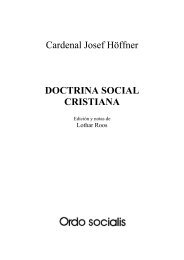Joseph Cardinal Höffner CHRISTIAN SOCIAL ... - Ordo Socialis
Joseph Cardinal Höffner CHRISTIAN SOCIAL ... - Ordo Socialis
Joseph Cardinal Höffner CHRISTIAN SOCIAL ... - Ordo Socialis
You also want an ePaper? Increase the reach of your titles
YUMPU automatically turns print PDFs into web optimized ePapers that Google loves.
lators and governors, but only secondarily and rather ‘administratively’ in the citizens (Thomas<br />
Aquinas II-II, 58,6).<br />
The legislator fulfills the duties of legal justice through a just legislation and administration<br />
above all. It demands of the citizens that they obey the laws and, in case of emergency, support<br />
the common good with property, person, and life. If legal justice is related to the state<br />
above all, it nevertheless enters the picture wherever it is necessary to preserve the common<br />
good. It is in this sense that Cajetan († 1534), for example, speaks of legal justice in the ecclesiastical<br />
realm, whereas Martin de Esparza († 1689) explicitly assigns it to the so-called ‘social’<br />
space as well by inculcating the duties of legal justice within the municipality, the trading<br />
company, and so on.<br />
4. Since the nineteenth century, a fourth kind of justice has customarily been placed next to<br />
the above-mentioned three fundamental forms of justice: social justice. At first, this designation<br />
was only a catchword behind which an unclear wish and demand did indeed stand, but<br />
not a scientific concept. The neoscholastic social philosopher Luigi Taparelli († 1862) was<br />
probably the first to have employed the expression ‘social justice’ in the not very clear sense<br />
of a justice ‘between man and man’. In 1848, Antonio Rosmini held up social justice, the content<br />
of which was unclearly defined, as a guiding principle in his proposal for a model Christian<br />
constitution. At the turn of the century, others designated ‘social justice’, which Thomas<br />
Aquinas allegedly did not know, as a „poisonous fruit of modernism“ and vehemently rejected<br />
both „word and substance.“ 34 In spite of these suspicions, the name spread more and<br />
more in Catholic literature and was taken up under Pius X in the official writings of the Roman<br />
Curia as well. Finally, in1931, the encyclical Quadragesimo anno pushed social justice<br />
so much to the centre that this important letter has been called the ‘encyclical of social justice’.<br />
Is social justice only a new name for a long familiar question, or is it a new law for the construction<br />
of social life that was not at all or not sufficiently noticed earlier? Many equate social<br />
justice with legal justice (e.g. A. Vermeersch, E. Genicot, L. Lachance, and P. Tischleder).<br />
Others limit social justice to natural-law requirements of the common good that are<br />
not established by law (e.g. E. Höring, A.E. Utz). Still others combine both legal and apportioning<br />
justice in the concept of social justice (H. Pesch, O. Schilling, and E. Welty). Others<br />
go further still and interpret social justice as „the harmony between legal, distributive, and<br />
commutative justice correctly conceived (B. Mathis, F. Cavallera).<br />
Whereas the above-mentioned definitions remain within the realms of the traditional three<br />
fundamental forms of justice, others would like to see in social justice a specifically new kind.<br />
Thus, for example, Johannes Messner affirms that social justice orders the relationship of intrasocietal<br />
groups and classes to one another, whereas the familiar division into three is „quite<br />
obviously“ related to the state. Gustav Gundlach, however, seeks to place social justice above<br />
the usual division into three. The three traditional fundamental forms are allegedly of a static<br />
nature; social justice, however, has a dynamic character, shapes the development of the legal<br />
system, and actualizes itself „in the three static forms of justice mentioned above.“<br />
In reality, social justice cannot be interpreted as a fourth fundamental form of cardinal virtue.<br />
It is rather identical with legal justice correctly understood. Those definitions are a priori excluded<br />
that subsume several fundamental forms of the cardinal virtue under social justice. For<br />
since a proper formal object is lacking to such a comprehensive term, a new fundamental<br />
form of justice cannot possibly be meant. Messner’s proposal to limit the scope of social justice<br />
to the relationships between social groups and classes is not convincing either, since a<br />
34 Cf. Jos. <strong>Höffner</strong>, Soziale Gerechtigkeit und soziale Liebe. Saarbrücken 1935, S. 10.<br />
44















